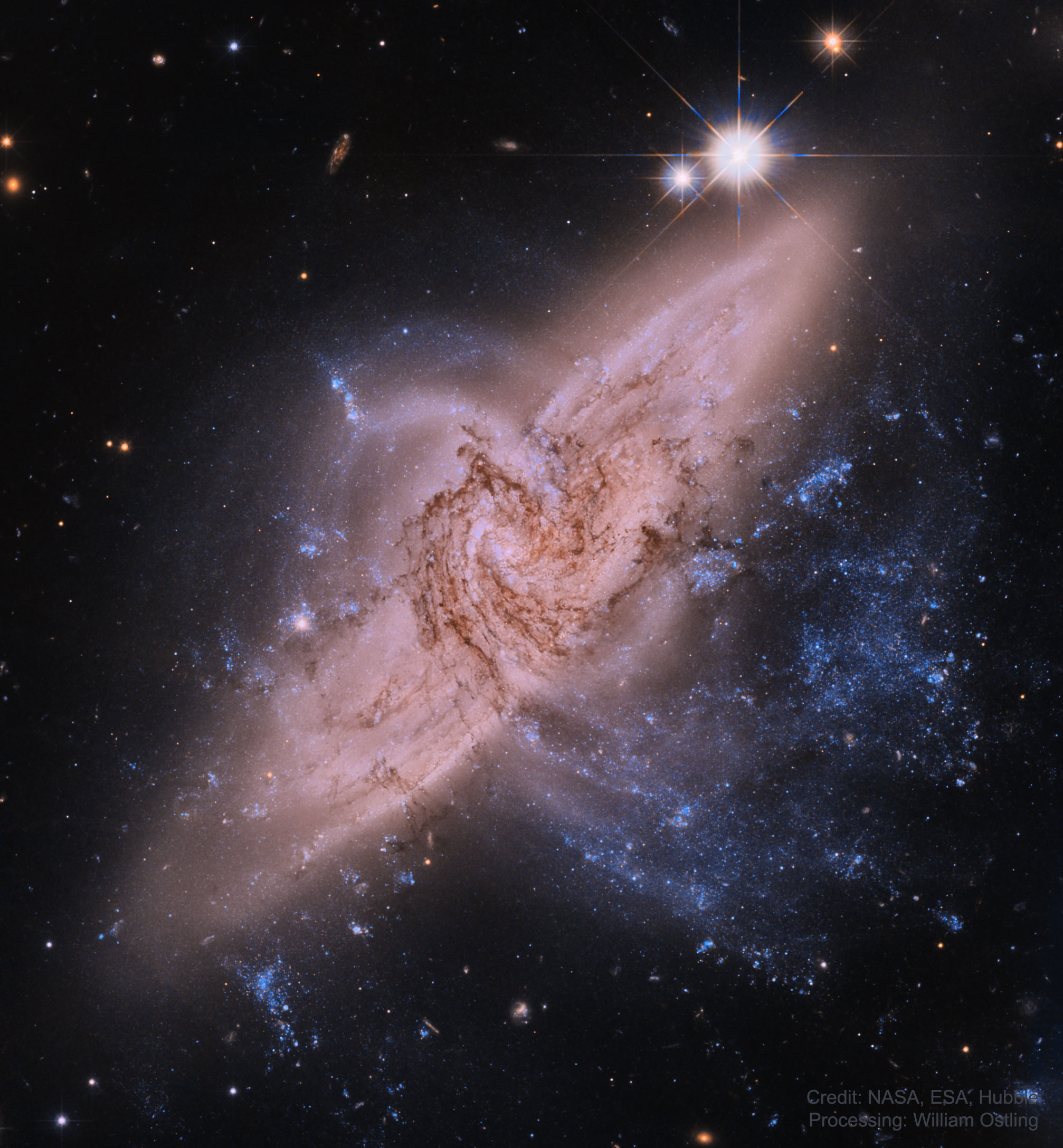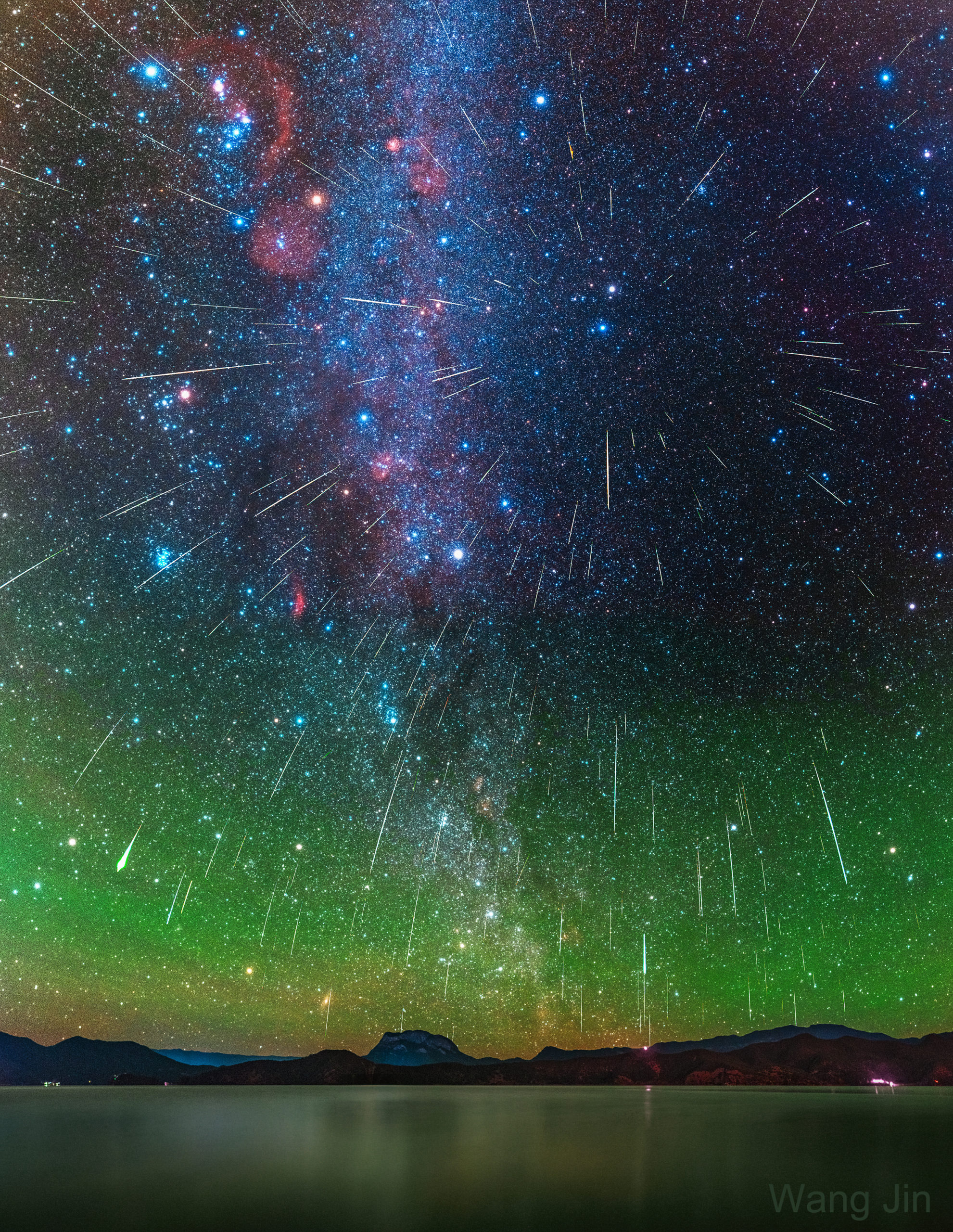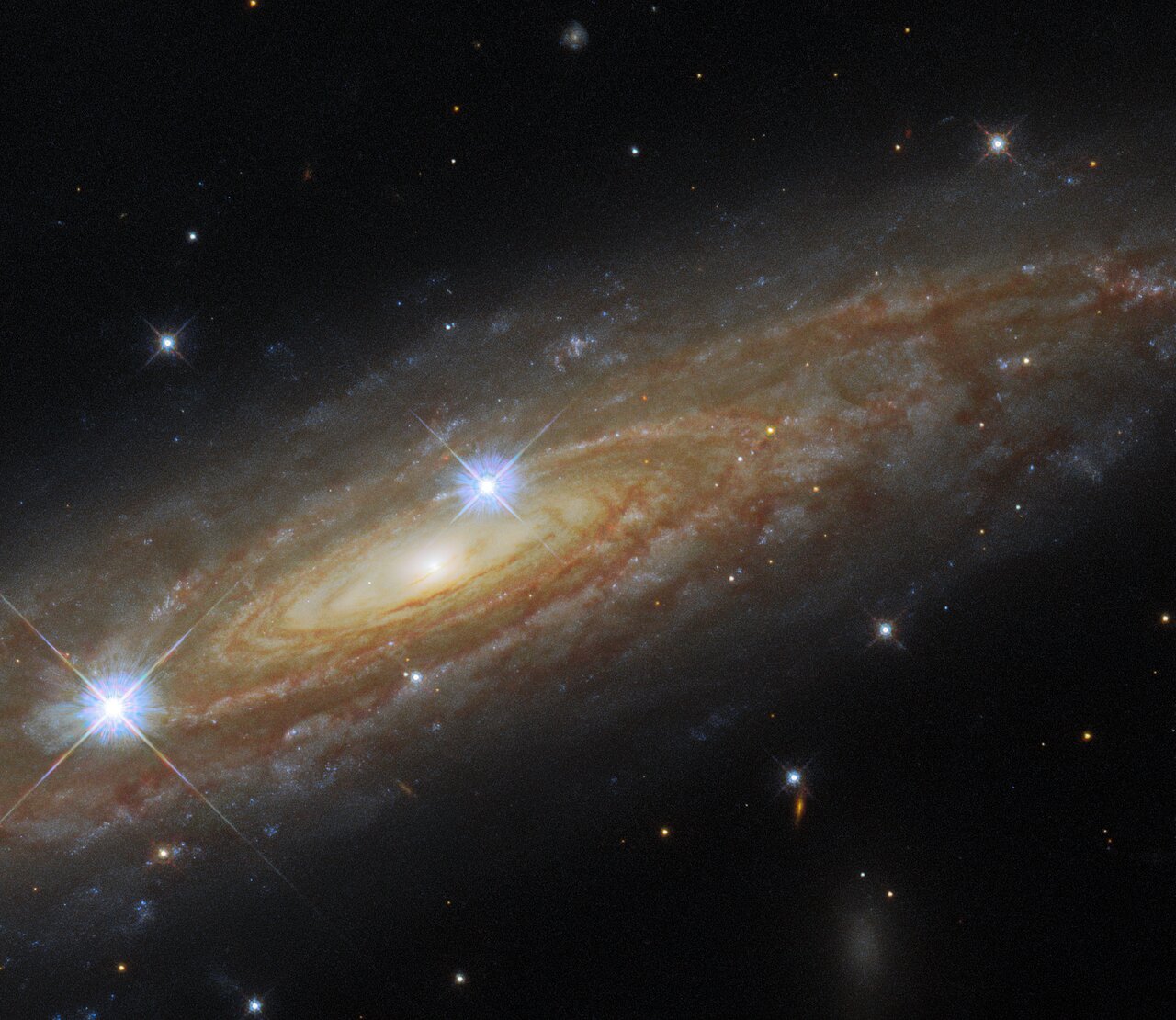Blog
Since both galaxies are so nearby, the angular shift is much smaller than the angular sizes of the galaxies themselves. The featured Hubble image of NGC 3314 shows two large spiral galaxies which happen to line up exactly. The foreground spiral NGC 3314a appears nearly face-on with its pinwheel shape defined by young bright star clusters. Against the glow of the background galaxy NGC 3314b, though, dark swirling lanes of interstellar dust can also be seen tracing the nearer spiral’s structure. Both galaxies appear on the edge of the Hydra Cluster of Galaxies, a cluster that is about 200 million light years away. Gravitational lens distortions are much easier to see when the lensing galaxy is smaller and further away. Then, the background galaxy may even be distorted into a ring around the nearer. Fast gravitational lens flashes due to stars in the foreground galaxy momentarily magnifying the light from stars in the background galaxy might one day be visible in future observing campaigns with high-resolution telescopes.

Imrat Khan (17 November 1935 – 22 November 2018) was an Indian sitar and surbahar player and composer. He was the younger brother of sitar maestro Ustad Vilayat Khan.
Imrat Khan was born in Calcutta on 17 November 1935 into a family of musicians tracing its roots back for several generations, to the court musicians of the Mughal rulers. The training in music traditionally has been passed down from father to son for nearly 400 years. He belonged to Etawah gharana also known as Imdadkhani gharana of classical musicians. Imrat Khan’s father was Enayat Khan (1895–1938), recognised as a leading sitar and surbahar player of his time, as had been his grandfather, Imdad Khan (1848–1920), before him. Imrat Khan’s father died when Imrat was a child, so he was raised by his mother, Bashiran Begum and her father, singer Bande Hassan Khan. In 1944, the family moved with Vilayat Khan, Imrat’s older brother, to Bombay where both the brothers learned sitar-playing extensively from their uncle Wahid Khan. In 1952, Vilayat and Imrat moved in together in Calcutta. They performed together for many years. The two brothers were part of the first cultural delegation to the Soviet Union and Eastern Europe in 1956.
more...David Werner Amram III (born November 17, 1930) is an American composer, arranger, and conductor of orchestral, chamber, and choral works, many with jazz flavorings. He plays piano, French horn, Spanish guitar, and pennywhistle, and sings.
Amram studied at the Oberlin Conservatory of Music in 1948–1949, and earned a bachelor’s degree in European history from George Washington University in 1952. In 1955 he enrolled at the Manhattan School of Music, where he studied under Dimitri Mitropoulos, Vittorio Giannini, and Gunther Schuller. Under Schuller he studied French horn.
Amram is a strong advocate for music education of the young. For over a quarter-century he served as music director for youth and family concert programs for the Brooklyn Philharmonic. Amram has pointed out: “It is tremendously important for professional people to work with the young. That is the way a true music culture is created — not through merchandising, but through love.”
more...Jack Owens became one of Mississippi’s most venerated blues artists in the 1980s and ‘90s after spending most of his life as a farmer in Yazoo County. Born November 17, 1904, or 1906 according to some sources, Owens did not perform outside the state of Mississippi until 1988. During his final years he and his harmonica player, Bud Spires, traveled together to many festivals and performed on Owens’s front porch for hundreds of visitors. Owens died on February 9, 1997.
Owens belonged to the pioneering generation of Bentonia bluesmen, which included Nehemiah “Skip” James (1902-1969) and Henry Stuckey (1897-1966). Stuckey is often regarded as the seminal local blues figure, but researchers have yet to discover any recordings or photographs of him. James ranks as Bentonia’s most internationally renowned musician, known for the striking quality of the music on his 1931 recordings for the Paramount label and for a briefly rejuvenated career during the blues revival of the 1960s. Just as James’s recording career was nearing its end, Owens was beginning his, in 1966; his first album, produced by musicologist Dr. David Evans, was not released until 1971. But during the following decades Owens became Bentonia’s resident celebrity. Local citizens grew accustomed to the sight of tour buses, vans, and cars with out-of-state license plates, sometimes loaded with cameras and recording equipment, heading for Owens’s house just north of this site off Rose Hill Road.
The music of Owens and James, as Evans wrote, was distinguished by “haunting, brooding lyrics dealing with such themes as loneliness, death and the supernatural . . . Altogether it is one of the eeriest, loneliest and deepest blues sounds ever recorded.” Neither Owens’s music nor his lifestyle in Bentonia changed much over the years. He clung to old ways and superstitions, including burying money in the ground and hanging bottles from his trees, and was reputed to be the last farmer in the area to plow with a mule. He once made moonshine and ran juke joints in or near his house. Even in his nineties he kept a pistol or shotgun at hand but claimed he had not shot anyone in several years. Documentary filmmakers were duly fascinated, and Owens appeared in Alan Lomax’s Land Where the Blues Began and Robert Mugge’s Deep Blues, as well as a commercial for Levi’s 501 Blues. After making a few festival appearances in Mississippi, he accepted offers to perform in Atlanta, St. Louis, Chicago, New York, Europe, and elsewhere, and took his first plane flight in 1992. The National Endowment for the Arts awarded him a National Heritage Fellowship in 1993.
more...Multiple Concerts and Conferences across Spain on International Flamenco Day 2021
The General Society of Authors and Editors (SGAE) has announced a series called El Latido Flamenco (Flamenco Heartbeat) to celebrate International Flamenco Day on November 16, 2021. The events include concerts, roundtables and a photographic exhibition.
The November 16 anniversary commemorates the proclamation of Flamenco by UNESCO (United Nations Educational, Scientific, and Cultural Organization) as Intangible Cultural Heritage of Humanity. SGAE joins this celebration in 2021 to disseminate what is undoubtedly one of the most representative and international symbols of Spanish culture.
El Latido Flamenco includes events in Madrid, Seville, Barcelona, Valencia, Santiago de Compostela and Zaragoza, with live performances by renowned flamenco artists. The series also includes roundtable discussions that will address issues such as the contribution and presence of women in flamenco and the challenges that the genre is currently facing.
Where are all of these meteors coming from? In terms of direction on the sky, the pointed answer is the constellation of Gemini. That is why the major meteor shower in December is known as the Geminids — because shower meteors all appear to come from a radiant toward Gemini. Three dimensionally, however, sand-sized debris expelled from the unusual asteroid 3200 Phaethon follows a well-defined orbit about our Sun, and the part of the orbit that approaches Earth is superposed in front of the constellation of Gemini. Therefore, when Earth crosses this orbit, the radiant point of falling debris appears in Gemini. Featured here, a composite of many images taken during the 2020 Geminids meteor shower shows over 200 bright meteors that streaked through the sky during the night December 14. The best meteor shower in November, the Leonids, peaks tonight and tomorrow. Unfortunately, this year, dim meteors during the early-morning peak will be hard to see against a sky lit by a bright gibbous moon. Still, a few bright Leonid meteors should be visible each hour.

Diana Jean Krall OC OBC (born November 16, 1964) is a Canadian jazz pianist and singer. She has sold more than 15 million albums worldwide, including over 6 million in the US. On December 11, 2009, Billboard magazine named her the second greatest jazz artist of the decade (2000–2009), establishing her as one of the best-selling artists of her time.
Krall is the only jazz singer to have had eight albums debuting at the top of the Billboard Jazz Albums. To date, she has won three Grammy Awardsand eight Juno Awards. She has also earned nine gold, three platinum, and seven multi-platinum albums.
Krall was born on November 16, 1964, in Nanaimo, British Columbia, Canada, the daughter of Adella A. (née Wende), an elementary school teacher, and Stephen James “Jim” Krall, an accountant. Krall’s only sibling, Michelle, is a former member of the Royal Canadian Mounted Police (RCMP). Krall’s father played piano at home and her mother sang in a community choir. Krall began studying piano herself at the age of four, and took exams through The Royal Conservatory of Music. In high school, she was a member of a student jazz group; at 15, she began playing professionally in local restaurants. Krall won a scholarship to attend the Berklee College of Music in Boston, where she studied from 1981 to 1983,before spending time in Los Angeles to play jazz. She returned to Canada to record her first album in 1992.
more...Hubert Charles Sumlin (November 16, 1931 – December 4, 2011) was a Chicago blues guitarist and singer, best known for his “wrenched, shattering bursts of notes, sudden cliff-hanger silences and daring rhythmic suspensions” as a member of Howlin’ Wolf‘s band. He was ranked number 43 in Rolling Stone‘s “100 Greatest Guitarists of All Time”.
Sumlin was born in Greenwood, Mississippi, and raised in Hughes, Arkansas. He got his first guitar when he was eight years old.[5] As a boy, he met Howlin’ Wolf by sneaking into a performance.
Wolf relocated from Memphis to Chicago in 1953, but his longtime guitarist Willie Johnson chose not to join him. In Chicago, Wolf hired the guitarist Jody Williams, but in 1954 he invited Sumlin to move to Chicago to play second guitar in his band. Williams left the band in 1955, leaving Sumlin as the primary guitarist, a position he held almost continuously (except for a brief spell playing with Muddy Waters around 1956) for the remainder of Wolf’s career. According to Sumlin, Howlin’ Wolf sent him to a classical guitar instructor at the Chicago Conservatory of Music to learn keyboards and scales. Sumlin played on the album Howlin’ Wolf (called the “rocking chair album”, with reference to its cover illustration), which was named the third greatest guitar album of all time by Mojo magazine in 2004.
more...Paul Hindemith (/ˈpaʊlˈhɪndəmɪt/; 16 November 1895 – 28 December 1963) was a prolific German composer, violist, violinist, teacher and conductor. He founded the Amar Quartet in 1921, touring extensively in Europe. As a composer, he became a major advocate of the Neue Sachlichkeit (new objectivity) style of music in the 1920s, with compositions such as Kammermusik, including works with viola and viola d’amore as solo instruments in a neo-Bachian spirit. Other notable compositions include his song cycle Das Marienleben (1923), Der Schwanendreher for viola and orchestra (1935), the opera Mathis der Maler (1938), the Symphonic Metamorphosis of Themes by Carl Maria von Weber (1943), and the oratorio When Lilacs Last in the Dooryard Bloom’d, a requiem based on Walt Whitman’s poem (1946).
more...Albert Edwin “Eddie” Condon (November 16, 1905 – August 4, 1973) was an American jazz banjoist, guitarist, and bandleader. A leading figure in Chicago jazz, he also played piano and sang.
Condon was born in Goodland, Indiana, the son of John and Margaret (née McGraw) Condon. He grew up in Momence, Illinois, and Chicago Heights, Illinois, where he attended St. Agnes and Bloom High School. After playing ukulele, he switched to banjo and was a professional musician by 1921.
When he was 15 years old, he received his first union card in Waterloo, Iowa.
more...William Christopher Handy (November 16, 1873 – March 28, 1958 Florence, AL) was a composer and musician who referred to himself as the Father of the Blues. Handy was one of the most influential songwriters in the United States. One of many musicians who played the distinctively American blues music, Handy did not create the blues genre but was the first to publish music in the blues form, thereby taking the blues from a regional music style (Delta blues) with a limited audience to a new level of popularity.
Handy was an educated musician who used elements of folk music in his compositions. He was scrupulous in documenting the sources of his works, which frequently combined stylistic influences from various performers.
more...This astronomical portrait from the NASA/ESA Hubble Space Telescope showcases an edge-on view of the majestic spiral galaxy UGC 11537. Hubble’s Wide Field Camera 3 has captured the tightly wound spiral arms swirling around the heart of UGC 11537 at infrared and visible wavelengths, showing both the bright bands of stars and the dark clouds of dust threading throughout the galaxy. UGC 11537 is 230 million light-years away in the constellation Aquila, and lies close to the plane of the Milky Way. Being so close to the starry band of the Milky Way means that foreground stars from our own galaxy have crept into the image — the two prominent stars in front of UGC 11537 are interlopers from within the Milky Way. These bright foreground stars are surrounded by diffraction spikes — imaging artifacts caused by starlight interacting with Hubble’s inner structure. This image came from a set of observations designed to help astronomers weigh supermassive black holes in distant galaxies. The combination of Hubble’s sharp-eyed observations and data from ground-based telescopes allowed astronomers to make detailed models of the mass of stars in these galaxies, which in turn helps constrain the mass of supermassive black holes.

Kevin Tyrone Eubanks (born November 15, 1957) is an American jazz and fusion guitarist and composer. He was the leader of The Tonight Show Band with host Jay Leno from 1995 to 2010. He also led the Primetime Band on the short lived The Jay Leno Show.
Eubanks was born into a musical family. His older brother, Robin Eubanks, is a trombonist, and his younger brother Duane Eubanks is a trumpeter.Two cousins are also musicians, the late bassist David Eubanks and the pianist Charles Eubanks. Kevin studied violin and trumpet before settling on the guitar.
more...William Edward “Little Willie” John (November 15, 1937 – May 26, 1968) was an American R&B singer who performed in the 1950s and early 1960s. He is best known for his successes on the record charts, with songs such as “All Around the World” (1955), “Need Your Love So Bad” (1956), “Talk to Me, Talk to Me” (1958), “Leave My Kitten Alone” (1960), “Sleep” (1960), and his number-one R&B hit “Fever” (1956). An important figure in R&B music of the 1950s, he faded into obscurity in the 1960s and died while serving a prison sentence for manslaughter. John was posthumously inducted into the Rock and Roll Hall of Fame in 1996.
John was born in Cullendale, Arkansas on November 15, 1937. He was one of ten children born to Lillie (née Robinson) and Mertis John. Many sources erroneously give his middle name as Edgar. His family moved to Detroit, Michigan, when he was four, so that his father could find factory work. In the late 1940s, the eldest children, including Willie, formed a gospel singing group. Willie also performed in talent shows, which brought him to the notice of Johnny Otis and, later, the musician and producer Henry Glover. After seeing him sing with the Paul “Hucklebuck” Williams orchestra, Glover signed him to a recording contract with King Records in 1955. He was nicknamed “Little Willie” for his short stature.
more...More Posts
- Pharoah Sanders
- Ray Brown
- Lee Konitz
- Art Tatum
- World Music July Vitraniuk
- Daily Roots The Congos
- Happy Yom Kippur 2024
- Mount Zion Yom Kippur Service
- Cosmos W63 (SNR G082.2+05.3)
- James “Sugar Boy” Crawford
- Nappy Brown
- Guitar Gabriel
- Harmonica Frank
- Tubby Hall
- Jay Epstein
- World Music Abdel Karim Ensemble
- Daily Roots Stephen Marley
- Truth Battleground States
- Nyabinghi Collection
- Cosmos Ring of Fire/Easter Island
